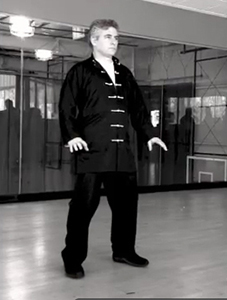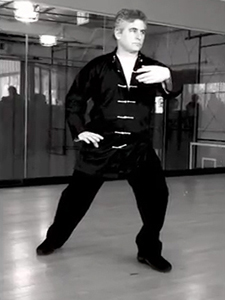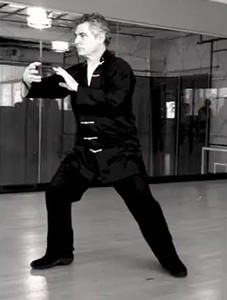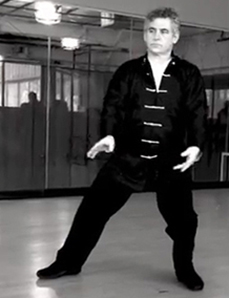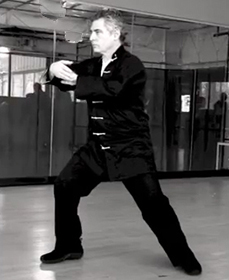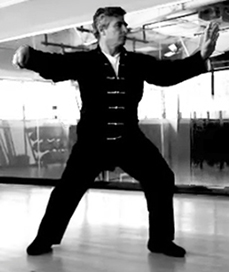
The First Lesson
Proper alignment is the first step in learning Taijiquan and acquiring skills. Everything is built on the foundation of efficient alignment.
The First Lesson
Structure is the first lesson of Taijiquan. Whether you participate in Taijiquan, purely for its martial capabilities, to improve your health, or for spiritual attainment, the method for learning begins by training your body. Bodies, by their very nature, are vulnerable to injury and illness. Your body carries you on the journey from birth until death. Caring for your body is essential for having a good quality of life.
Strength without Effort
The human physique is made up of bones, sinews, muscles, and organs. The core of the body’s physical strength resides in the skeletal system. Far stronger than muscles, the bones facilitate movement and structural integrity while moving through life. By properly aligning the skeletal frame, the muscles function optimally relieving them from holding your balance up from the force of gravity. Since the fear of falling is a primal fear based on the power of gravity, the ability to move through the world with a harmonious relationship to gravity frees you from the preoccupation with that fear. The freedom you gain releases mental and physical powers. You can move with minimal effort and gain the best of your faculties for handling any situation that arises.
The untrained person typically relies on muscular strength to hold the body in position. In Taijiquan the connective tissues (the ligaments and fascia) maintain the alignment so that the practitioner can relax the muscles.
Solo Forms
The solo forms are the foundation for learning. They begin by cultivating a balanced relationship with gravity. Balance is established by a pure alignment with the power of gravity. Gravity aligns with the radius coming from the center of the earth. Given that we live in the constant condition of gravity, Taijiquan skills begin with developing a keen relationship with gravity.
Balance and Center
Optimal balance is product of having your weight of the body pass through a single vertical line. However, because humans stand on two feet, it is difficult to be aware of a pure center of balance. In Taijiquan practice this is called the error of being double weighted. To be double weighted means there are two centers. Two centers like a wheel with two axles cannot rotate. It may be able to shift, but anything with two centers can’t rotate. Were the centerline able to penetrate the ground, it would thereafter follow a straight, virtual path to the center of the planet. By having a single centerline rotational movement becomes possible.
Human beings have two legs. Atop the two legs ride the two hip joints. These bear the weight of the torso and foster rotational movement on top of two legs. This ability requires significant training. Above the hips in the lower abdomen is Dantian. To discover the Dantian, you must attune your awareness to what you feel in the lower abdomen. Picture a small sphere in the center of your belly. Through this center all the movement of the body passes.
Your feet are the connection to the ground. They generate a root, the solid foundation from which you move. Because you have two feet yet want one center, you must translate the two into one. To make this translation, you must make clear where the single center of your weight passes vertically toward the ground. The vertical weight drop is only possible if you release any tension held—especially from the hip joint to the ribs.
The Complexity of Maintaining Center While Moving
Muscles tense for two main reasons: to move and to resist falling. The fear of falling is reflexive. It is built into the mind and body. Only when your weight is centered can it be considered balanced. When you are balanced, you relieve from duty the part of your mind that makes sure you aren’t losing your balance. The easiest way to picture this is to have all the weight on one leg. Since this is rarely the case with bipedal creatures, Taijiquan first teaches you to drop your weight through one point. That point can move between the right and left hips. In order to achieve this, you must be able to distinguish where your weight is and where your weight is not. In other words, you must distinguish Yin from Yang. Once you can tell the two aspects apart, you proceed to move while maintaining a pure center. To do this you must be able to smoothly change your centerline’s position while maintaining its verticality.
All the while your weight changes from one foot to the other you centerline remains upright. To put this in the context of Yin and Yang, the weight bearing leg receives the movement. The unweighted leg initiates movement. Prior to the moment of weight exchange the receptive weight-bearing leg changes its intention to becoming the initiating leg. At the same time, the unweighted leg changes its intention to become the receiving leg. In this order, the weight transition doesn’t interrupt the centerline. This complicated skill requires full attention in order to perform consistently.
Moving Weight from One Leg to the Other
When correctly changing from yin to yang, or from weighted to unweighted there is a subtle sequence that transpires. The Taiji symbol made up of Yin and Yang is a static representation of a dynamic process. In reality it represents constant change and movement. The black and white shapes swirl and shift from one to the other without break or interruption. This implies that there is a gradual exchange as one transform into the other. In movement the gradual shift involves becoming aware of and being intentional with the process of weight change beginning with the mental intention to change. That decision is followed immediately by a response in the body as the intention affects the musculo-skeletal system. It is at this point in the process that careful attention must be paid to the feeling of change within the body structure prior to the weight shift. In the Taijiquan description this is known as "The mind leads the Qi."
The pre-movement phase comes with specific, subtle sensations as the soft tissues—particularly the legs and lower back region—as the muscles and fascia release and elongate on the unweighted leg while the weighted leg releases and compresses. Once the sensation of release has initiated, it is possible to permit your weight to gradually change from one leg to the other. This is known among Taijiquan practitioners as "The Qi leads the Body."
Pivoting Around the Center
One insightful translation of Taijiquan is the Grand Pivot. Pivoting requires a stationary point in the center. Like a compass inscribing a circle, both stillness (Yin) and rotation (Yang) are necessary. Taijiquan movements are based on the concept of pivoting and spiraling. Circles are two dimensional, spirals three. Spirals unite the elements of a line and a circle. There is forward or backward movement along the line. The circular rotation generates the progress. As with a drill, the spiral action is key to the power. If the center becomes vague, it degenerates into what is known as double weighted. With two centers, pure rotation is compromised or completely eliminated. Imagine a wheel with a slightly bent axle. It may be able to continue to roll, but it will wobble.
In this regard it is understandable why the purity of yin and yang needs to be distinguished in Taijiquan. The problem is that the sensitivity required to be able to recognize even the smallest deviation takes time, perseverance, and patience to acquire. Where the errors are most recognizable is by the results of interactions during the partner training of push hands. The use of muscular strength to achieve a push is a clear indicator of an error. Getting jammed, fighting, collapsing, and using your partner for support all indicate the fundamental error of losing center.
